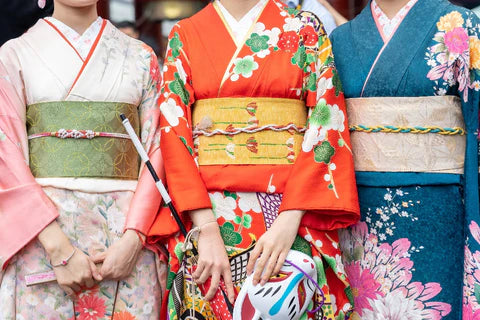
History of Japanese Kimono
History of Japanese Kimono
This page explores the fascinating history of Japanese kimono from their origins in Han Chinese clothing to the revival that is occurring today.
The word kimono translates as 'a thing to wear'!

The Origins of Japanese Kimono
The earliest kimono were heavily influenced by hanfu (Han Chinese clothing) following Japanese embassies to China. They first came into fashion in Japan during the eighth century, and their designs became increasingly elaborate during the peaceful Heian era (794 - 1192 AD), with different styles for different ages, ranks and occasions. Heian noblewomen wore junihitoe, twelve flowing layers of kimono, with each layer carefully chosen to complement the season and occasion. A looser, less cumbersome, lightweight kimono (called yukata) was usually worn after taking a bath.
The wars of the turbulent Kamakura period (1185 - 1333 AD) brought about a shift in priorities, with practicality presiding over ostentation. Men of the newly risen samurai class donned hitatare, a relatively restrained attire with fewer layers and smaller sleeves, while noblewomen wore the same white kosode (basic Japanese robes) and red hakama (pleated trousers) as their lower-ranked subjects.
The ongoing power struggle between the Imperial and Samurai classes during the Muromachi period (1392 - 1573 AD) coincided with further developments in Japanese fashion. Women started using obi (sash/belt) to secure their kosode, and hakama were subsequently abandoned in favour of a single-piece outer garment, which started to take on colours and patterns. The men's hitatare became increasingly decorative, although practicality remained top priority.
The Rise of the Japanese Kimono
The end of the civil war during the Azuchi-Momoyama era (1573 to 1600) was a pivotal moment in the history of Japanese clothing. Commerce reopened and Japanese craftsmen started taking an interest in the artistic techniques that were being used elsewhere in the world.
The Edo period (1603-1867) saw a return to fashion influenced by Chinese styles, and an opulent new aesthetic was borne out of the desire of the emerging merchant class to obtain the finer things in life. Thin crepes, damasks and satins became firmly integrated into weavers' repertoires, along with new techniques of dyeing, printing and embroidery.
The ruling samurai class attempted to clamp down on these displays of wealth by banning the use of complicated dyeing techniques and precious threads. However, the introduction of a new resist-dyeing technique, yuzen, enabled the merchant class to sidestep this problem, and eventually gave rise to a whole host of further techniques in kimono-dyeing, many of which are still used to make formal kimono today.
Driven by increasing demand from city-dwellers and actors as well as the imposition of new laws under the Shogunate, the evolution of Japan's fashion industry gathered pace. Sleeves became longer and obis wider, and by the mid-Edo period, kimono structure had reached its modern form. Yukata also enjoyed a surge in popularity, led by the increased use of public bathhouses around this time.
The Decline of the Japanese Kimono
Reforms imposed during the Meiji restoration (1868 - 1912) brought about significant political, social and economic change in Japan. Westernisation drove an increased desire for convenience, and many traditional Japanese customs were forced into decline. Little by little, yukata replaced kimono as the everyday garment of choice, although formal kimono remained popular amongst geisha, performers and sumo wrestlers and for use on special occasions such as weddings, festivals and tea ceremonies.
Gradually, the education, infrastructure and emergency services sectors began to adopt western-style uniform. A series of natural, financial and manmade disasters devastated Shirokiya, Japan's largest retailer, starting with the Tokyo earthquake of 1923 which was closely followed by a major fire later that year. The final blow came during the Second World War and subsequent military occupation of Japan, which left the department store's assets in tatters.
The partial dismantling and reconstruction of Japanese industry after the war forced many performers and artisans into factory work, and many of Japan's traditional arts and customs were once again sidelined to make way for industrial growth. In 1940, kokumin-fuku (western-style uniform), was declared mandatory for males.

Japanese Kimono today
Nowadays, the vast majority of Japanese people wear western clothes. However, yukata experienced a revival during the late 1990s and now they can often be seen at festivals and firework displays, especially during the hot summer months. Kimono sales in the fashion-conscious Harajuku district of Shibuya Ward, Tokyo have exploded in recent years and many young people have started mixing and matching them with western accessories to make a statement.
In 2014 a new trend for kimono-style cardigans captivated the west, boosting demand for kimono in turn, and this trend continues to dominate western high street fashion to this day.

For a more detailed insight into the turbulent past of yukata and the other types of kimono, read Katie Armstrong's five-part History of Kimono.
Visit The Japanese Shop website to view and buy from their unique and exclusive range of authentic Japanese kimono and yukata.